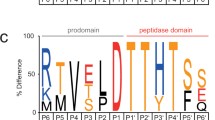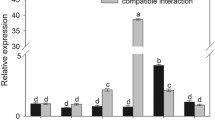Abstract
Programmed cell death (PCD) in plant cells is often accompanied by biochemical and morphological hallmarks similar to those of animal apoptosis. However, orthologs of animal caspases, cysteinyl aspartate-specific proteases that constitute the core component of animal apoptosis, have not yet been identified in plants. Recent studies have revealed the presence of a family of genes encoding proteins with distant homology to mammalian caspases, designated metacaspases, in the Arabidopsis thaliana genome. Here, we describe the isolation of LeMCA1, a type-II metacaspase cDNA clone from tomato (Lycopersicon esculentum Mill.). BLAST analysis demonstrated that the LeMCA1 gene is located in close vicinity of several genes that have been linked with PCD. Southern analysis indicated the existence of at least one more metacaspase in the tomato genome. LeMCA1 mRNA levels rapidly increased upon infection of tomato leaves with Botrytis cinerea, a fungal pathogen that induces cell death in several plant species. LeMCA1 was not upregulated during chemical-induced PCD in suspension-cultured tomato cells.





Similar content being viewed by others
Abbreviations
- DIG:
-
digoxigenin
- hpi:
-
hours post inoculation
- HR:
-
hypersensitive response
- NB:
-
nucleotide binding
- ORF:
-
open reading frame
- PCD:
-
programmed cell death
- PCR:
-
polymerase chain reaction
- RACE:
-
rapid amplification of cDNA ends
References
Benito EP, Ten Have A, Van 't Klooster JW, Van Kan JAL (1998) Fungal and plant gene expression during synchronized infection of tomato leaves by Botrytis cinerea. Eur J Plant Pathol 104:207–220
Cakouros D, Daish T, Martin D, Baehrecke EH, Kumar S (2002) Ecdysone-induced expression of the caspase DRONC during hormone-dependent programmed cell death in Drosophila is regulated by Broad-Complex. J Cell Biol 157:985–995
Chin YE, Kitagawa M, Kuida K, Flavell RA, Fu XY (1997) Activation of the STAT signaling pathway can cause expression of caspase 1 and apoptosis. Mol Cell Biol 17:5328–5337
Danon A, Delorme V, Mailhac N, Gallois P (2000) Plant programmed cell death: a common way to die. Plant Physiol Biochem 38:647–655
De Jong AJ, Hoeberichts FA, Yakimova ET, Maximova E, Woltering EJ (2000) Chemical-induced apoptotic cell death in tomato cells: involvement of caspase-like proteases. Planta 211:656–662
De Jong AJ, Yakimova ET, Kapchina VM, Woltering EJ (2002) A critical role for ethylene in hydrogen peroxide release during programmed cell death in tomato suspension cells. Planta 214:537–545
Diaz J, ten Have A, van Kan JA (2002) The role of ethylene and wound signaling in resistance of tomato to Botrytis cinerea. Plant Physiol 129:1341–1351
Dickman MB, Park YK, Oltersdorf T, Li W, Clemente T, French R (2001) Abrogation of disease development in plants expressing animal antiapoptotic genes. Proc Natl Acad Sci USA 98:6957–6962
Govrin EM, Levine A (2000) The hypersensitive response facilitates plant infection by the necrotrophic pathogen Botrytis cinerea. Curr Biol 10:751–757
Greenberg JT (1996) Programmed cell death: a way of life for plants. Proc Natl Acad Sci USA 93:12094–12097
Hengartner MO (2000) The biochemistry of apoptosis. Nature 407:770–776
Hoeberichts FA, Orzaez D, Van der Plas LHW, Woltering EJ (2001) Changes in gene expression during programmed cell death in tomato cell suspensions. Plant Mol Biol 45:641–654
Jarvis WR (1980) Taxonomy. In: Coley-Smith JR, Verhoef K, Jarvis WR (eds) The biology of Botrytis. Academic press, London, pp 1–18
Lam E, Kato N, Lawton M (2001) Programmed cell death, mitochondria and the plant hypersensitive response. Nature 411:848–853
Madeo F, Herker E, Maldener C, Wissing S, Lächelt S, Herlan M, Fehr M, Lauber K, Sigrist SJ, Wesselborg S, Fröhlich KU (2002) A caspase-related protease regulates apoptosis in yeast. Mol Cell 9:1–20
Orzaez D, De Jong AJ, Woltering EJ (2001) A tomato homologue of the human protein PIRIN is induced during programmed cell death. Plant Mol Biol 46:459–468
Pontier D, Godiard L, Marco Y, Roby D (1994) HSR203 J, a tobacco gene whose activation is rapid, highly localized and specific for incompatible plant/pathogen interactions. Plant J 5:507–521
Shin DH, Kang H, Han KH (1999) A Hevea brasiliensis homolog (HbLAR) of an arabidopsis hypothetical protein gene YUP8H12R.4 is expressed abundantly in latex and is not induced either by ethylene or wounding. Plant Physiol 121:1384 (PGR 99–184)
Spassova MI, Prins TW, Folkertsma RT, Klein-Lankhorst RM, Hille J, Goldbach RW, Prins M (2001) The tomato gene Sw-5 is a member of the coiled coil, nucleotide binding, leucine-rich repeat class of plant resistance genes and confers resistance to TSWV in tobacco. Mol Breed 7:151–161
Steller H (1995) Mechanisms and genes of cellular suicide. Science 267:1445–1449
Szallies A, Kubata BK, Duszenko M (2002) A metacaspase of Trypanosoma brucei causes loss of respiration competence and clonal death in the yeast Saccharomyces cerevisiae. FEBS Lett 517:144–150
Uren AG, O'Rourke K, Aravind L, Pisabarro MT, Seshagiri S, Koonin EV, Dixit VM (2000) Identification of paracaspases and metacaspases. Two ancient families of caspase-like proteins, one of which plays a key role in MALT lymphoma. Mol Cell 6:961–967
Van der Biezen EA, Jones JD (1998) The NB-ARC domain: a novel signalling motif shared by plant resistance gene products and regulators of cell death in animals. Curr Biol 8: R226–227
Van der Vlugt-Bergmans CJB, Wagemakers CAM, Van Kan JAL (1997) Cloning and expression of the cutinase A gene of Botrytis cinerea. Mol Plant Microbe Interact 10:21–29
Von Mering M, Wellmer A, Michel U, Bunkowski S, Tlustochowska A, Bruck W, Kuhnt U, Nau R (2001) Transcriptional regulation of caspases in experimental pneumococcal meningitis. Brain Pathol 11:282–295
Woltering EJ, Van der Bent A, Hoeberichts FA (2002) Do plant caspases exist? Plant Physiol 130:1764–1769
Zou H, Henzel WJ, Liu X, Lutschg A, Wang X (1997) Apaf-1, a human protein homologous to C. elegans CED-4, participates in cytochrome c-dependent activation of caspase-3. Cell 90:389–390
Acknowledgements
The authors thank Rina Michaeli for technical assistance. We are indebted to Prof. Linus van der Plas (Wageningen University) and Dr. Sander van der Krol (Wageningen University) for critically reading the manuscript and stimulating discussions. This work was supported by the Dutch Ministry of Agriculture, Nature Management and Fisheries.
Author information
Authors and Affiliations
Corresponding author
Rights and permissions
About this article
Cite this article
Hoeberichts, F.A., ten Have, A. & Woltering, E.J. A tomato metacaspase gene is upregulated during programmed cell death in Botrytis cinerea-infected leaves. Planta 217, 517–522 (2003). https://doi.org/10.1007/s00425-003-1049-9
Received:
Accepted:
Published:
Issue Date:
DOI: https://doi.org/10.1007/s00425-003-1049-9




